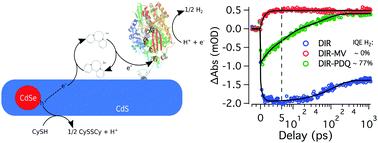当前位置:
X-MOL 学术
›
Energy Environ. Sci.
›
论文详情
Our official English website, www.x-mol.net, welcomes your
feedback! (Note: you will need to create a separate account there.)
Balancing electron transfer rate and driving force for efficient photocatalytic hydrogen production in CdSe/CdS nanorod–[NiFe] hydrogenase assemblies
Energy & Environmental Science ( IF 32.4 ) Pub Date : 2017-09-14 00:00:00 , DOI: 10.1039/c7ee01738c Bryant Chica 1, 2, 3, 4 , Chang-Hao Wu 4, 5, 6, 7 , Yuhgene Liu 1, 2, 3, 4 , Michael W. W. Adams 4, 6, 7, 8 , Tianquan Lian 1, 2, 3, 4 , R. Brian Dyer 1, 2, 3, 4
Energy & Environmental Science ( IF 32.4 ) Pub Date : 2017-09-14 00:00:00 , DOI: 10.1039/c7ee01738c Bryant Chica 1, 2, 3, 4 , Chang-Hao Wu 4, 5, 6, 7 , Yuhgene Liu 1, 2, 3, 4 , Michael W. W. Adams 4, 6, 7, 8 , Tianquan Lian 1, 2, 3, 4 , R. Brian Dyer 1, 2, 3, 4
Affiliation

|
We describe a hybrid photocatalytic system for hydrogen production consisting of nanocrystalline CdSe/CdS dot-in-rod (DIR) structures coupled to [NiFe] soluble hydrogenase I (SHI) from Pyrococcus furiosus. Electrons are shuttled to the catalyst by a redox mediator, either methyl viologen (MV2+, E0 = −446 mV vs. NHE) or propyl-bridged 2-2′-bipyridinium (PDQ2+, E0 = −550 mV vs. NHE). We demonstrate nearly equal photoreduction efficiencies for the two mediators, despite extracting ∼100 mV of additional driving force for proton reduction by PDQ2+. Femtosecond to microsecond transient absorption reveals that while electron transfer (ET) from the DIR to PDQ2+ is slower than for MV2+, in both cases the ET process is complete by 1 ns and thus it efficiently outcompetes radiative decay. Long-lived charge separation is observed for both mediators, resulting in similar net efficiencies of photoreduction. Whereas both mediators are readily photoreduced, only PDQ2+ yields measurable H2 production, demonstrating the importance of optimizing the electron shuttling pathway to take advantage of the available reducing power of the DIR excited state. H2 production in the PDQ2+ system is highly efficient, with an internal quantum efficiency (IQE) as high as 77% and a TONSHI of 1.1 × 106 under mild (RT, pH = 7.35) conditions.
中文翻译:

在CdSe / CdS纳米棒– [NiFe]氢化酶组件中平衡电子传递速率和驱动力以有效地光催化制氢
我们描述了一种混合的光催化制氢系统,该系统由纳米晶体CdSe / CdS点对点(DIR)结构与激烈热球菌[NiFe]可溶性加氢酶I(SHI)耦合而成。电子通过甲基紫精(MV 2 +,E 0 = -446 mV vs. NHE)或丙基桥接的2-2'-联吡啶(PDQ 2 +,E 0 = -550 mV )的氧化还原介体穿梭到催化剂上与NHE)。我们展示了两种介体的光还原效率几乎相同,尽管通过PDQ 2+提取了约100 mV的额外驱动力来进行质子还原。。飞秒到微秒的瞬态吸收表明,虽然从DIR到PDQ 2+的电子转移(ET)慢于MV 2+,但在两种情况下ET过程都完成了1 ns,因此它有效地超过了辐射衰减。两种介体均观察到长寿命电荷分离,从而导致相似的净光还原效率。尽管两种介体都易于光还原,但只有PDQ 2+产生可测量的H 2生成量,这表明优化电子穿梭路径以利用DIR激发态的可用还原能力的重要性。PDQ 2+中的H 2产生该系统非常高效,在温和(RT,pH = 7.35)条件下,内部量子效率(IQE)高达77%,TON SHI为1.1×10 6。
更新日期:2017-10-11
中文翻译:

在CdSe / CdS纳米棒– [NiFe]氢化酶组件中平衡电子传递速率和驱动力以有效地光催化制氢
我们描述了一种混合的光催化制氢系统,该系统由纳米晶体CdSe / CdS点对点(DIR)结构与激烈热球菌[NiFe]可溶性加氢酶I(SHI)耦合而成。电子通过甲基紫精(MV 2 +,E 0 = -446 mV vs. NHE)或丙基桥接的2-2'-联吡啶(PDQ 2 +,E 0 = -550 mV )的氧化还原介体穿梭到催化剂上与NHE)。我们展示了两种介体的光还原效率几乎相同,尽管通过PDQ 2+提取了约100 mV的额外驱动力来进行质子还原。。飞秒到微秒的瞬态吸收表明,虽然从DIR到PDQ 2+的电子转移(ET)慢于MV 2+,但在两种情况下ET过程都完成了1 ns,因此它有效地超过了辐射衰减。两种介体均观察到长寿命电荷分离,从而导致相似的净光还原效率。尽管两种介体都易于光还原,但只有PDQ 2+产生可测量的H 2生成量,这表明优化电子穿梭路径以利用DIR激发态的可用还原能力的重要性。PDQ 2+中的H 2产生该系统非常高效,在温和(RT,pH = 7.35)条件下,内部量子效率(IQE)高达77%,TON SHI为1.1×10 6。











































 京公网安备 11010802027423号
京公网安备 11010802027423号